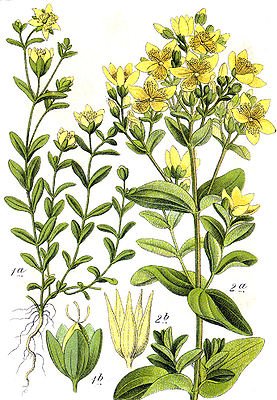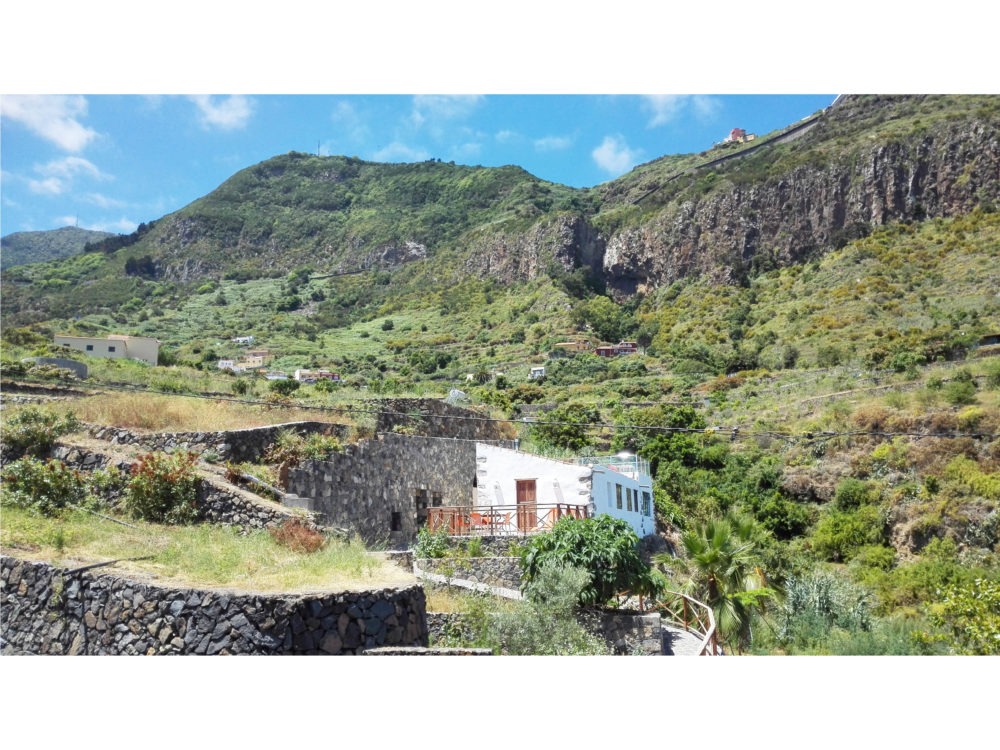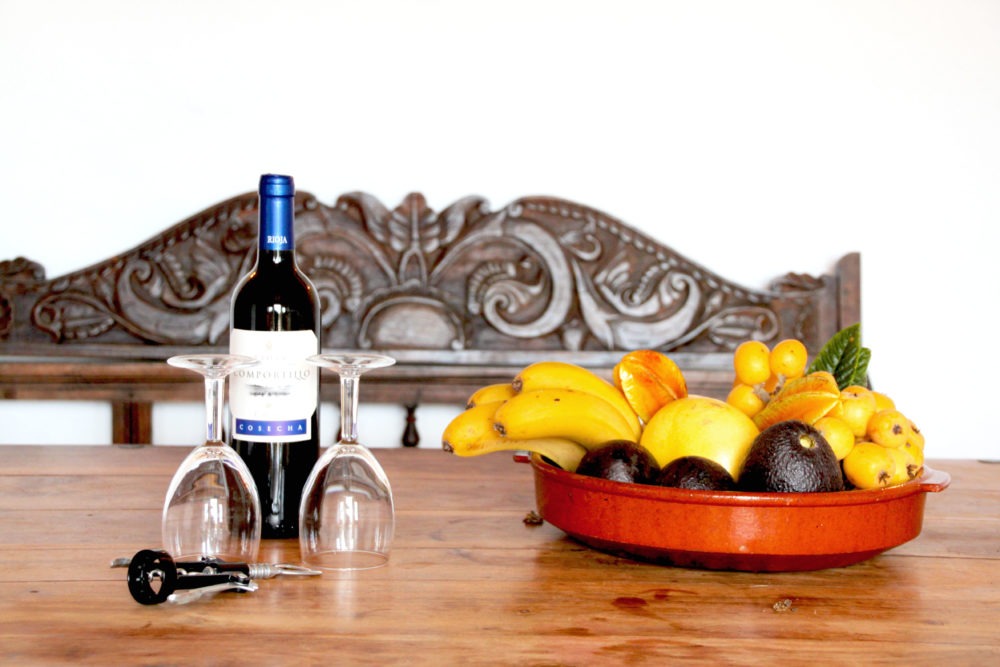Hypericum canariense
Johanniskraut (kanarisches)
Englische Bezeichnung: St. Johns Wort, Amber, Goatsweed …
Spanische Bezeichnung: Hierba de San Juan
Familie
Hypericaceae (Hartheugewächse)
Hauptbestandteile:
Naphthodianthone (Hypericin, Pseudohypericin), ätherische Öle, Gerbstoffe, Flavonoide (Hyperosid, Rutin), Harze, Alkaloide, Phloroglucinole (Hyperforin)
Verwendbare Teile:
Blätter, Blüten
Wirkungsweise:
-
Antiviral
-
Antibakteriell
-
Antidepressiv
-
Antimikrobiell
-
Leicht bitteres Tonikum
-
Entspannend
-
Entzündungshemmend
-
Nervenstärkend
-
Wundheilend
Geschmack:
Adstringierend, Bitter, Leicht süßlich
Energie:
Kühlend, Trocken
Ernte-Hinweise:
Die offenen Blüten, Blütenknospen und Blätter von den obersten 2-3 Zentimetern der Pflanze werden während der vollen Blütezeit von Juni bis August geerntet und in einer Tinktur oder Öl extrahiert oder für Tee oder pulverisierten Extrakt getrocknet. Der bioaktive Inhaltsstoff Hypericin wird in frischen Alkohol- oder Ölzubereitungen gut extrahiert, bleibt aber in der getrockneten Pflanze nicht erhalten; daher werden frische Kräuterzubereitungen bevorzugt.
Johanniskraut hat eine erhebende, freudige Natur, die die Mittsommersonne ausstrahlt. Sie ist ein wirkungsvolles Hilfsmittel bei Wunden, Prellungen, Verbrennungen, Verstauchungen und Muskelschmerzen. Als aufgegossenes Öl, Salbe oder Umschlag verwendet, lindert Johanniskraut Schmerzen, Schwellungen und Entzündungen, die mit vielen Verletzungen verbunden sind, die die Haut und Muskeln betreffen. Seine antiseptischen Eigenschaften helfen, Infektionen bei Wunden und Verbrennungen vorzubeugen.
Referenzen/ References:
American Botanical Council. (1999). The Commission E monographs: St. John’s wort. Retrieved from http://cms.herbalgram.org/commissione/Monographs/Monograph0347.html
American Botanical Council. (2000). Herbal medicine: Expanded Commission E. St. John’s wort. Retrieved from http://cms.herbalgram.org/expandedE/StJohn27swort.html
Chevallier, A. (1996). The encyclopedia of medicinal plants. New York, NY: DK Publishing.
Edwards, G.F. (2000). Opening our wild hearts to the healing herbs. Woodstock, NY: Ash Tree Publishing.
Foster, S. (1993). Herbal renaissance. Layton, UT: Peregrine Smith Books.
Grieve, M. (1971). A modern herbal. (Original work published 1931). Retrieved from http://botanical.com/botanical/mgmh/s/sajohn06.html
Hardin, K.R. (2014). Gifts of the solstice: Native St. John’s wort. Retrieved from http://bearmedicineherbals.com/gifts-of-the-solstice-native-st-johns-wort.html
Hoffmann, D. (2003). Medical herbalism. Rochester, VT: Healing Arts Press.
Holmes, P. (1997). The energetics of Western herbs (3rd ed., Vol. I). Boulder, CO: Snow Lotus Press.
Hypericum Depression Trial Study Group. (2002). Effect of Hypericum perforatum (St. John’s wort) in major depressive disorder: A randomized controlled trial. Journal of the American Medical Association, 287(14), 1807-1814. https://doi.org/10.1001/jama.287.14.1807
Laakmann, G., Schüle, C., Baghai, T., & Kieser, M. (1998). St. John’s wort in mild to moderate depression: The relevance of hyperforin for the clinical efficacy. Pharmacopsychiatry, 31, 54-59. https://doi.org/10.1055/s-2007-979346
Linde, K., Berner, M., & Kriston, L. (2008). St John’s wort for major depression. The Cochrane Database of Systematic Reviews, 2008(4), CD000448. https://doi.org/10.1002/14651858.CD000448.pub3
McIntyre, A. (1996). Flower power. New York, NY: Henry Holt and Company.
Miller, A.L. (2005). Epidemiology, etiology, and natural treatment of seasonal affective disorder. Alternative Medicine Review, 10(1), 5-13. https://doi.org/10.1136/ebmh.12.3.78
Rapaport, M.H., Nierenberg, A.A., Howland, R., Dording, C., Schettler, P.J., & Mischoulon, D. (2011). The treatment of minor depression with St. John’s Wort or citalopram: Failure to show benefit over placebo. Journal of Psychiatric Research, 45(7), 931-941. https://doi.org/10.1016/j.jpsychires.2011.05.001
Samadi, s., Khadivzadeh, T., Emami, A., Moosavi, N.S., Tafaghodi, M., & Behnam, H.R. (2010). The effect of Hypericum perforatum on the wound healing and scar of cesarean. Journal of Alternative Complementary Medicine, 16(1), 113-117. https://doi.org/10.1089/acm.2009.0317
Tierra, L. (2003). Healing with the herbs of life. Berkeley, CA: Ten Speed Press.
Tillotson, A.K. (2001). The one earth herbal sourcebook. New York, NY: Kensington Publishing Group.
Family
Hypericaceae
Parts Used:
Leaves & Flowers
Properties:
-
Antiviral
-
Antibacterial
-
Antidepressant
-
Antimicrobial
-
Slightly bitter tonic
-
Relaxing
-
Anti-inflammatory
-
Nerve-strengthening
-
Wound-healing
Harvesting Guidelines:
The open flowers, flower buds and leaves from the top 2-3 centimetres of the plant are harvested during the full flowering period from June to August and extracted in a tincture or oil or dried for tea or powdered extract. The bioactive ingredient hypericin is well extracted in fresh alcohol or oil preparations but is not retained in the dried plant; therefore, fresh herbal preparations are preferred.
St. John’s wort has an uplifting, joyful nature that radiates the midsummer sun. It is an effective remedy for wounds, bruises, burns, sprains and muscle pain. Used as an infused oil, ointment or poultice, St John’s wort relieves pain, swelling and inflammation associated with many injuries affecting the skin and muscles. Its antiseptic properties help prevent infections in wounds and burns.
Familia
Hypericaceae
Partes aprovechables:
Hojas & Flores
Propiedades:
-
Antiviral
-
Antibacterias
-
Antidepresivos
-
Antimicrobiano
-
Tónica ligeramente amarga
-
Relajante
-
Antiinflamatorio
-
Fortalecimiento de los nervios
-
Curación de heridas
Indicaciones de Cosecha:
Las flores abiertas, los capullos y las hojas de los 2-3 centímetros superiores de la planta se recogen durante el periodo de floración completa, de junio a agosto, y se extraen en forma de tintura o aceite, o se secan para hacer un té o un extracto en polvo. El ingrediente bioactivo hipericina se extrae bien en las preparaciones frescas de alcohol o aceite, pero no se conserva en la planta seca; por lo tanto, se prefieren las preparaciones de hierbas frescas.
La hierba de San Juan tiene un carácter edificante y alegre que irradia el sol de pleno verano. Es un remedio eficaz para las heridas, contusiones, quemaduras, esguinces y dolores musculares. Utilizada como aceite en infusión, pomada o cataplasma, la hierba de San Juan alivia el dolor, la hinchazón y la inflamación asociados a muchas lesiones que afectan a la piel y los músculos. Sus propiedades antisépticas ayudan a prevenir infecciones en heridas y quemaduras.









































